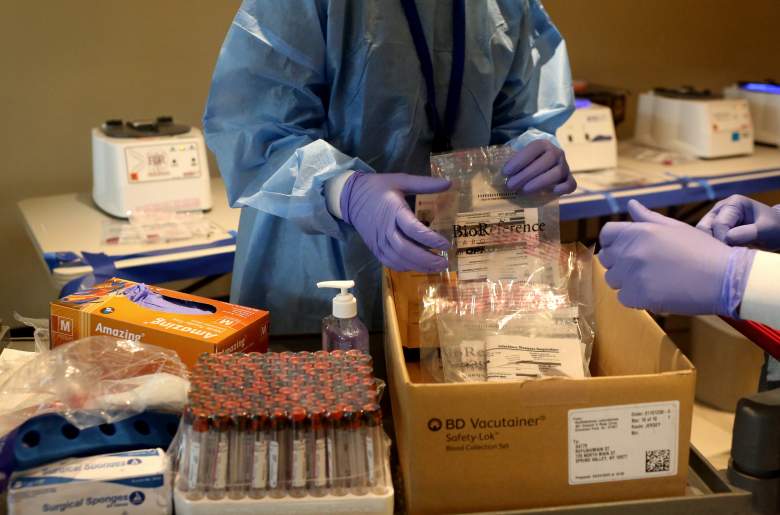
Getty When should K-12 schools reopen due to coronavirus?
The COVID-19 pandemic has disrupted the schooling of K-12 children throughout the United States. As states grapple with whether to have in-person schooling in the fall, the federal government has published new guidelines for schools if they decide to reopen.
“As some communities in the United States open K-12 schools, CDC offers the following considerations for ways in which schools can help protect students, teachers, administrators, and staff and slow the spread of COVID-19,” the Centers for Disease Control and Prevention wrote on May 19, 2020.
If followed, the CDC’s new guidelines could change school life as we know it, from recess to congregating with friends in the school cafeteria. Communal spaces such as playgrounds should be closed if possible: “Close communal use shared spaces such as dining halls and playgrounds with shared playground equipment if possible,” advises CDC. It’s suggested that children bring their own meals and eat in a classroom not a communal dining area. Field trips should be virtual if possible.
The CDC also released a school reopening decision tool that you can find here.
Whether to open, though, is a decision that should be made at the local level, according to CDC. “Schools can determine, in collaboration with state and local health officials to the extent possible, whether and how to implement these considerations while adjusting to meet the unique needs and circumstances of the local community. Implementation should be guided by what is feasible, practical, acceptable, and tailored to the needs of each community,” CDC wrote.
The new guidelines provoked some anger online. One woman wrote on Twitter, “I am sick of non-government officials telling us what to do! We did not vote for them. Where is our say? Here are the guidelines for opening schools. Not only does it sound like a prison, but now we need twice the amount of classrooms, teachers, and buses. No!!!”
What do the CDC guidelines actually say?
Here’s what you need to know:
The CDC Says There Are Different Risk Levels in K-12 Schools & Face Coverings Should Be Worn ‘as Feasible’
Should schools require face masks or other coverings? According to CDC, they should do so “as feasible.”
Teach and reinforce use of cloth face coverings. Face coverings may be challenging for students (especially younger students) to wear in all-day settings such as school. Face coverings should be worn by staff and students (particularly older students) as feasible, and are most essential in times when physical distancing is difficult.
The CDC rules say that face masks should not be placed on:
Children younger than 2 years old
Anyone who has trouble breathing or is unconscious
Anyone who is incapacitated or otherwise unable to remove the cloth face covering without assistance
The CDC guidance for K-12 schools spells out activities that create different levels of risk:
Lowest Risk: Students and teachers engage in virtual-only classes, activities, and events.
More Risk: Small, in-person classes, activities, and events. Groups of students stay together and with the same teacher throughout/across school days and groups do not mix. Students remain at least 6 feet apart and do not share objects (e.g., hybrid virtual and in-person class structures, or staggered/rotated scheduling to accommodate smaller class sizes).
Highest Risk: Full sized, in-person classes, activities, and events. Students are not spaced apart, share classroom materials or supplies, and mix between classes and activities.
According to CDC, “COVID-19 is mostly spread by respiratory droplets released when people talk, cough, or sneeze.” As a result, “handwashing, staying home when sick) and environmental cleaning and disinfection” are guiding principles for a safe environment, CDC reports.
The CDC suggests that schools encourage people to stay home when appropriate and “Teach and reinforce handwashing with soap and water for at least 20 seconds and increase monitoring to ensure adherence among students and staff.”
The schools are also encouraged to have healthy hygiene supplies, including “soap, hand sanitizer with at least 60 percent alcohol (for staff and older children who can safely use hand sanitizer), paper towels, tissues, disinfectant wipes, cloth face coverings (as feasible) and no-touch/foot-pedal trash cans.”
Schools are advised to post signs and get out the message about healthy hygiene. It’s suggested they regularly clean and disinfect surfaces that get touched a lot, like “playground equipment, door handles, sink handles, drinking fountains.” Letting students share objects is discouraged if they can’t be easily disinfected.
CDC suggests modified layouts in buses and classrooms:
Space seating/desks at least 6 feet apart when feasible.
Turn desks to face in the same direction (rather than facing each other), or have students sit on only one side of tables, spaced apart.
Create distance between children on school buses (g., seat children one child per row, skip rows) when possible.
According to Harvard Medical School, children can get COVID-19. “Children, including very young children, can develop COVID-19. Many of them have no symptoms,” Harvard advises. “Those that do get sick tend to experience milder symptoms such as low-grade fever, fatigue, and cough. Some children have had severe complications, but this has been less common. Children with underlying health conditions may be at increased risk for severe illness.”
READ NEXT: California Doctor Criticizes State’s COVID-19 Approach